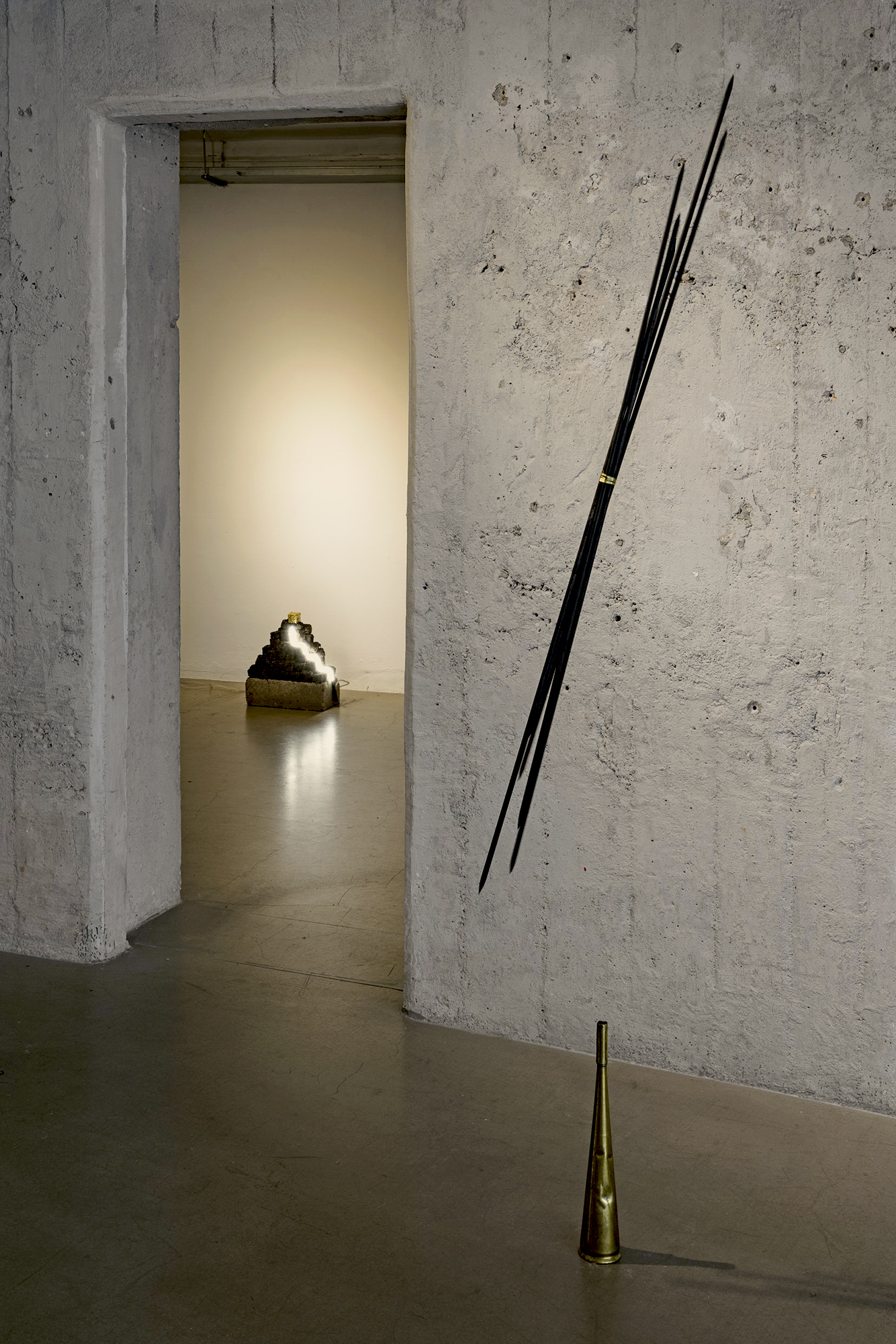GLARE
solo exhibition in Contemporary Museum Wrocław
curator: Joanna Kobyłt
17 Sep 2021—7 Mar 2022
Most of the works were realised
during the stipend of Wrocław City 2021
photos: Małgorzata Kujda, Kama Sokolnicka
More about Glare (Blask) in Polish:
https://muzeumwspolczesne.pl/

Heralds of a New Order
installation; print on silk, thread, brass, vent
180 x 150 x 2 cm
2021
This gilded, silky flag with the motif of a pleated skirt waves slightly as the air moves, in a symbolic gesture of support for the women right's movement in Poland.
installation view, "Glare" in Contemporary Museum Wrocław, 2022
Joanna Kobyłt: "Heralds of a New Order" Kamy Sokolnickiej ⟶

"Urania Propitia"
assamblage; paper, wood, brass,
30 x 40 x 3 cm
2021
The work makes an indirect reference to Maria Cunitz, a Lower Silesian astronomer, author of the book Urania Propitia* and populariser of knowledge about the solar system. This Schweidnitz-born scientist wrote the first book on astronomy in the German language (the dominant language of science at that time was Latin), in which she corrected Johannes Kepler’s Rudolphine Tables—an astronomical catalogue from 1627 describing the stars and motions of planets. She also observed the phases of Venus and discovered an impact crater on its surface. According to the reports on the life of the 17th-century researcher, her lifestyle was considered controversial by her con- temporaries: she slept during the day and worked at night. Despite her immense contributions to science, Cunitz is much less known than her male colleagues living at the same time (Kepler, Galileo, Hevelius).
The work is an attempt to restore the memory of women’s contribution to the develop- ment of knowledge and the process of explaining the world, which has been marginalised for centuries. Maria Cunitz is a rocket shining with an inner glow; a persistent scientist who had to contend with the social limitations of her time.
*Urania Propitia, i.e. “astronomy made understandable to the reader”

Thanka, 40ºC
installation; velvet, threads, turned-off fluorescent lamps
240 x 140 x 4 cm
2021
31ºC
collage; paper, brass
2021

Italian Woman
collage; wood, paper, brass, vermiculite fabric
2021

Passive Fire Protection
installation; woolen fleece, brass, vermiculite fabric, wood, steel, cow leather from the second-hand; sound
2021

Post-growth Cone, 2021
concrete, soil, golden leaves, neon, cable
25 x 35 x 50 cm
Accumulator of goodness, the Post-growth Cone, has been laid out of pressed soil-blocks on a foundation made of construction waste, a concrete block. A kind of stupa—a mound-like structure containing Buddhist relics that is used as a place of meditation—as a tribute to the degrowth movements. A stream of neon light is flowing down the cone, dried blocks of the nutritious, pressed soil are “cultures” for new seeds, on top a gilded nugget has been placed. The work refers to Walter Benjamin's metaphor of progress as a chaotically growing ruin of history.


detail

Death Valley, 56°C
concrete, reed, lamp, brass, 24-kr gold
various dimensions, 2021
installation view, Contemporary Museum Wrocław, 2022

Crystal Stranglers
installation; selenite, rock crystal, felt, wool, glass, brass
variable dimensions, 2021
The installation refers to the work of landscape architect Roberto Burle Marx, located in Praça dos Cristais (Crystal Square) in Brasilia. Burle Marx was inspired by the stone mine in the town of Cristalina—locality was a characteristic feature of his style. He was famous for his approach to nature; he studied rainforests and was involved in their protection. He was interested in the relationships and interactions between different species of plants and animals and their influence on the life of the entire garden.
Concrete, attractive for politics as well as for artists, for decades was supposed to be a response to the housing deficit around the world. The charm was broken by its excessive use that hugely contributed to the degradation of the natural environment. The ambivalence fuels Crystal Stranglers that juxtaposes two very different properties of minerals. Selenite is a well structured mineral while rock crystal has no structure, it breaks to uncountable fragments and melts like glass in high temperature.

a footnote to the installation

detail

installation view,
Contemporary Museum Wrocław, 2022
In Curved Air
video installation
editing: Emanuel Geisser
2021
One afternoon, during the April 2020 lockdown, I was listening to Terry Riley’s album A Rainbow in Curved Air. At one point, the interior of her flat brightened with sunlight, and a reflection of the rotating record appeared on the wall above the turntable. This video is a song on emanations of being in everyday surroundings. Shining with reflected light, the moving halo resembles the rings of Saturn, introducing a broader, planetary context.

Photometric Solid of Light
paper, pencil, crayon
15 x 20 cm
2021

To Leave The Solar System This Month
sculpture; brass, acrylic glass
8 x 120 x 4 cm, 2017

